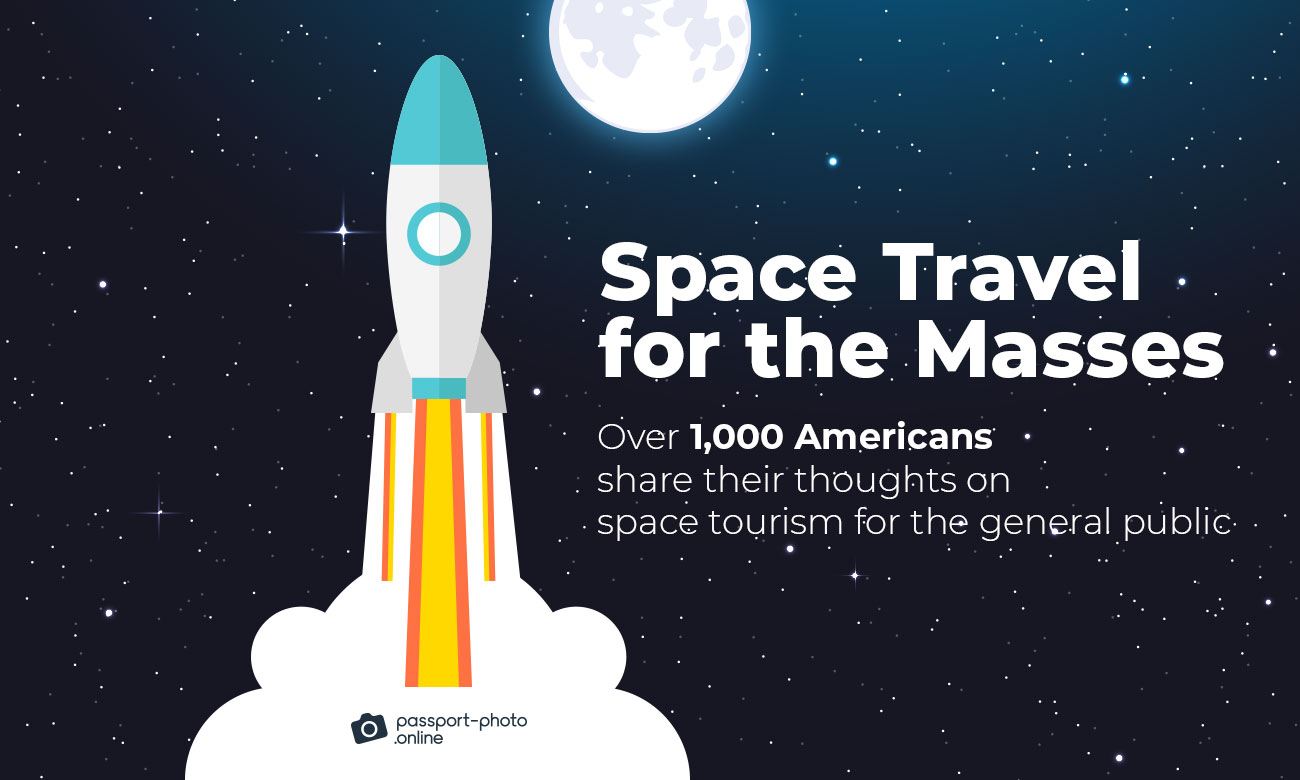Let’s be honest:
The prospect of seeing the Earth’s curvature has always been, well, out of this world. After all, space is considered the final frontier, a luxury only the ultra-rich could afford.
But—
When Amazon founder Jeff Bezos and British billionaire Richard Branson first took spacecraft for a spin to the outer limits with civilians on board in 2021, their flights arguably marked a new era of civilian space tourism.
More importantly, they sparked hope mere mortals like us could also experience the Gs in our lifetime.
So, at Passport Photo Online, we’ve decided to survey 1,000+ Americans to get their POV on space tourism for the general public, learn what’s the most they would pay to explore the great unknown, and much more.
Keep scrolling to see our findings.
United Space of America
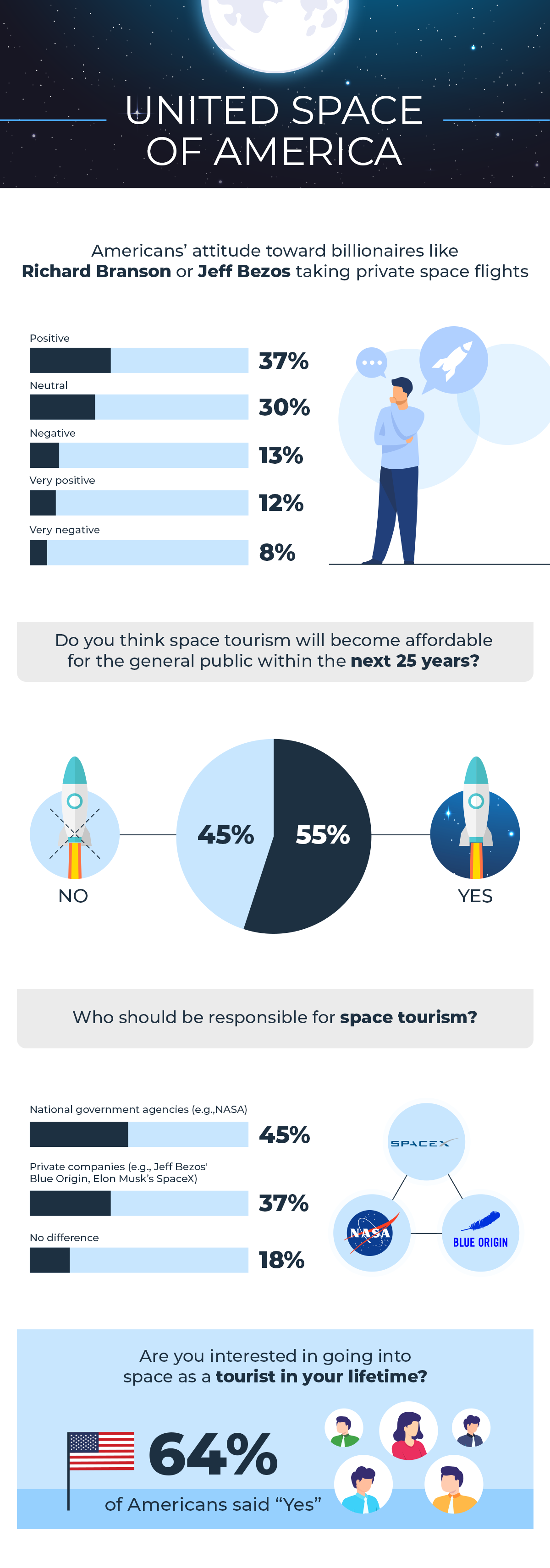
To begin with, we wanted to gauge Americans’ attitude toward said billionaires taking private space flights. Below are the results:
- Positive: 37%
- Neutral: 30%
- Negative: 13%
- Very positive: 12%
- Very negative: 8%
As you can see, not everyone is excited about the billionaire space race. While their pioneering trips to the edge of the outer hemisphere have pushed space science forward, they also stirred a hornet’s nest in the media.
For one, a single rocket launch produces up to 300 tons of carbon dioxide, which is between about 50 and 100 times more than the one to three tons per passenger on a long-haul flight. That means the space tourism industry will likely come with vast environmental costs.
Two, many critics called Jeff Bezos’ and Richard Branson’s space flights nothing but an unnecessary and overpriced joyride for the super-elites, given there are many pressing issues to tackle on planet Earth.
But—
Despite a fair amount of criticism, Virgin Galactic and Blue Origin, among other space tourism companies, heralded an important step toward making space travel more accessible. In fact, Bank of America estimates the total value of the space industry will reach $2.7 trillion by 2040.
So, we asked the respondents if they believe space tourism will become affordable for the general public within the next 25 years. A full 55% of Americans said “Yes”.
As a follow-up, we also asked who should be responsible for space tourism:
- National government agencies (e.g., NASA): 45%
- Private companies: 37%
- No difference: 18%
Lastly, we asked Americans if they are generally interested in going into space as tourists in their lifetime. It turns out, six out of 10 Americans (64%) want to travel to space. Yet, that number jumps to a whopping 82% for the respondents who indicated they previously engaged in adventurous activities (e.g., skydiving, snowboarding, rock climbing).
What’s also interesting is that after a closer data examination, we found that men, in particular, are more interested in space travel than women (74% vs. 54%). On top of it, age plays a role in people’s desire to “reach for the stars.”
Here’s how different demographics compare:
- Gen Zers (25 or younger): 80%
- Millennials (26–38): 71%
- Gen Xers (39–54): 62%
- Baby Boomers (55+): 38%
So—
Most Americans (particularly younger generations and those with an adventuresome spirit) indeed want to fly to space in their lifetime. See below what fuels their desire to fly up.
Why Americans Want to Go to Space
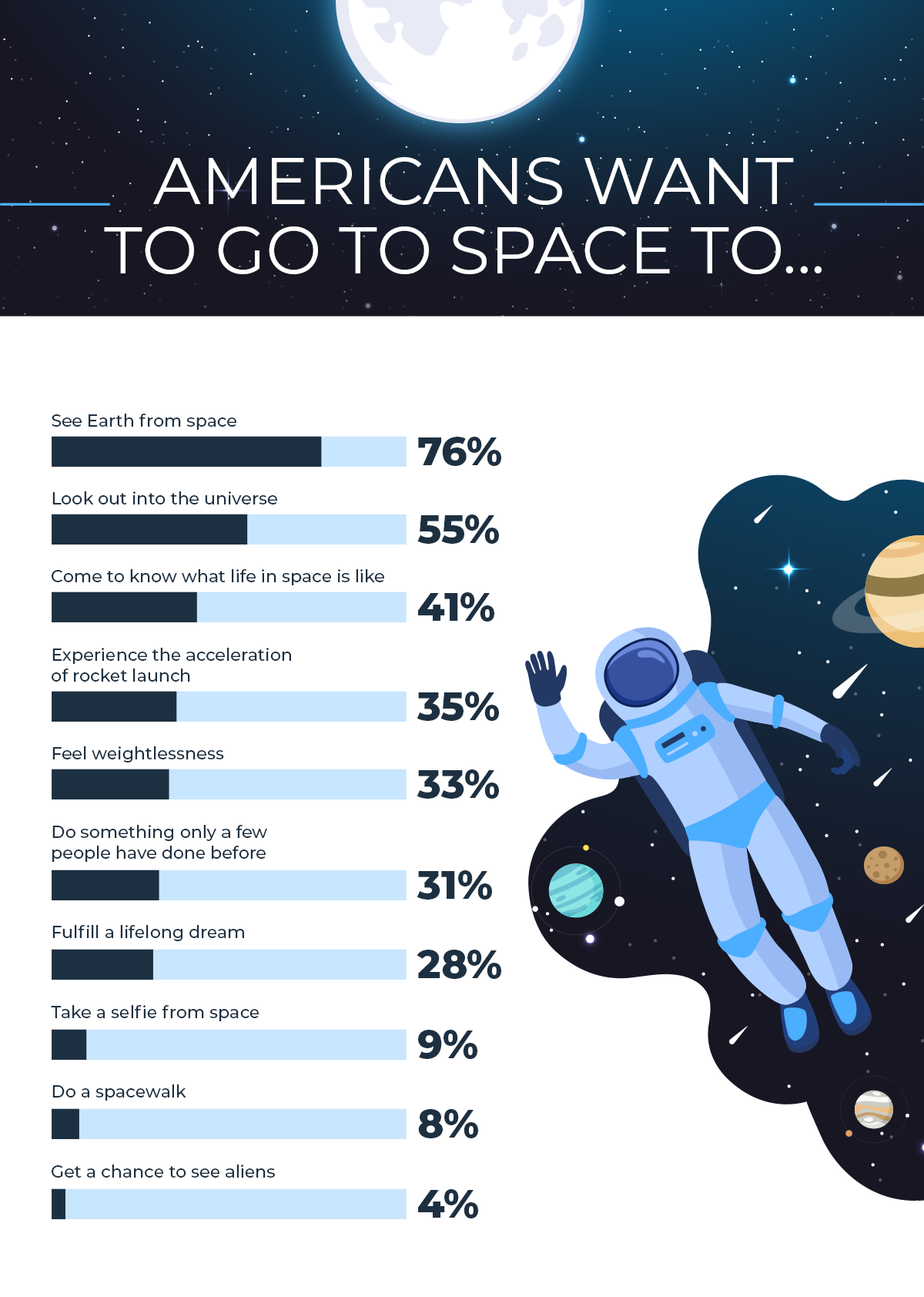
Without further ado, here are Americans’ top ten reasons to travel to space:
- To see Earth from space: 76%
- To look out into the universe: 55%
- To come to know what life in space is like: 41%
- To experience the acceleration of a rocket launch: 35%
- To feel weightlessness: 33%
- To do something only a few people have done before: 31%
- To fulfill a lifelong dream: 28%
- To take a selfie from space: 9%
- To do a spacewalk: 8%
- To get a chance to see aliens: 4%
As you can tell, most people want to see the Earth. That makes sense: there’s hardly any greater beauty than seeing our planet from up high.
In fact, it even triggers a “cognitive shift in awareness”, which manifests in a higher sense of responsibility for the environment and a stronger bond to the planet, according to astronauts like Michael Collins and Rusty Schweikart, among others.
Here’s an account of the former:
“The thing that really surprised me was that it [Earth] projected an air of fragility. And why, I don’t know. I don’t know to this day. I had a feeling it’s tiny, it’s shiny, it’s beautiful, it’s home, and it’s fragile.”
But—
For the sake of justice, it’s important to note that as of today, both Blue Origin and Virgin Galactic go to the edge of space, not into orbit. So, you only get around 15 minutes to see Earth, which isn’t the same as seeing it from above and having days to reflect and contemplate.
There’s an option, however, to go to orbit and spend a few days there. To do it, you’d need to hop on Elon Musk’s SpaceX Starship and shell out $200 million for a seat vs. $200,000–$450,000 to fly on Virgin Galactic’s Space or Blue Origin’s New Shepard.
To the Final Frontier
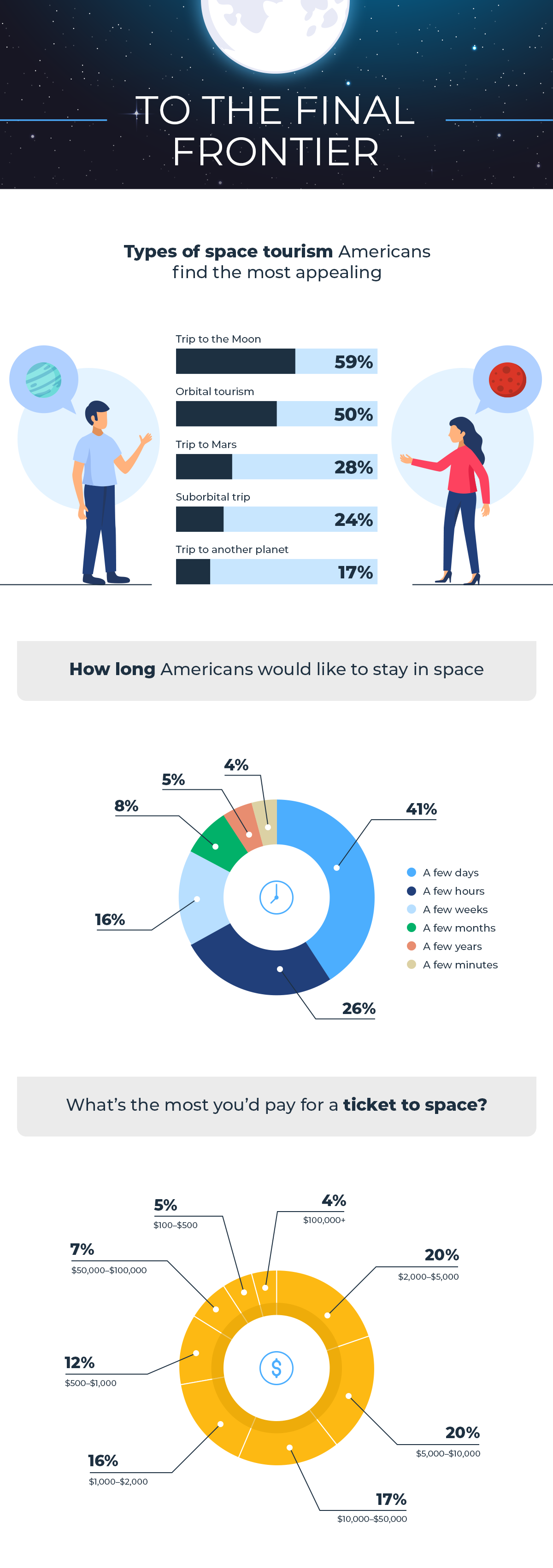
At this point, we wanted to ask Americans how they’d want to tour space regardless of what space tourism companies have on offer today.
So—
Here are the types of space tourism Americans find the most appealing:
- Trip to the Moon: 59%
- Orbital tourism (e.g., offered by SpaceX): 50%
- Trip to Mars: 28%
- Suborbital trip (e.g., offered by Blue Origin): 24%
- Trip to another planet: 17%
Interestingly, most want to walk on the moon just like Neil Armstrong did back in 1969, followed by half of Americans who want to orbit Earth.
Next, we asked the respondents how long they’d like to stay in space:
- A few days: 41%
- A few hours: 26%
- A few weeks: 16%
- A few months: 8%
- A few years: 5%
- A few minutes: 4%
Last but not least, we asked what’s the most Americans would pay for a ticket to space. Below are the results:
- $2,000–$5,000: 20%
- $5,000–$10,000: 20%
- $10,000–$50,000: 17%
- $1,000–$2,000: 16%
- $500–$1,000: 12%
- $50,000–$100,000: 7%
- $100–$500: 5%
- $100,000+: 4%
Thus, only 4% of Americans would splurge $100,000+ for a ride to space.
It’s also noteworthy that the respondents who stated their income last year was $100,000 and greater were much more likely than others to say they’d pay $100,000+ for a ticket: 20% vs. 4%.

Do you need passport photos? Find out more:
Reasons Some Would Pass On a Space Trip
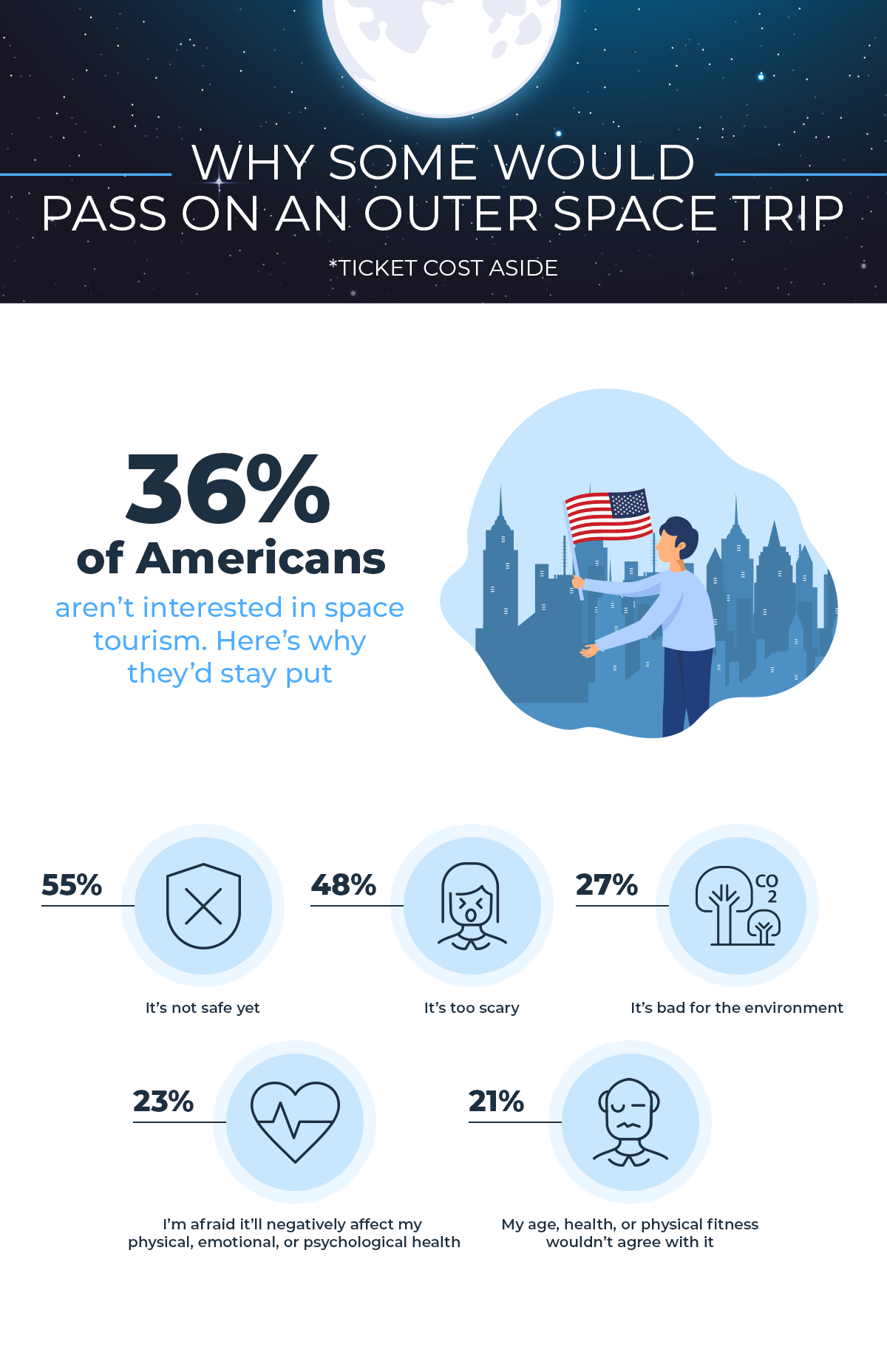
We get it:
Not everyone wants to climb up a rocket and experience a massive kick in the back as you rip through the layers of the atmosphere under several million pounds of thrust—all while the rocket is rattling like a skyscraper in an earthquake. Mr. Howard Wolowitz can attest to that.
As a result, 36% of Americans aren’t interested in space tourism, and not just because of the price. Here are the top five reasons why some prefer to stay put:
- It’s not safe yet: 55%
- It’s too scary: 48%
- It’s bad for the environment: 27%
- I’m afraid it’ll negatively affect my physical, emotional, or psychological health: 23%
- My age, health, or physical fitness wouldn’t agree with it: 21%
So, most of those who don’t want to fly to space are unsure about the safety aspect or fear things might go south. As many as 27% are concerned about the carbon footprint. While the new rockets are more energy-efficient than older ones, they still burn tons of fuel.
Some people are also afraid of the health-related consequences. At this stage, we dug into the data and saw that Baby Boomers (aged 55 or older) are more likely than others to state a space trip would harm their health: 42% vs. 21%.
Space Travel: What Americans Fear the Most
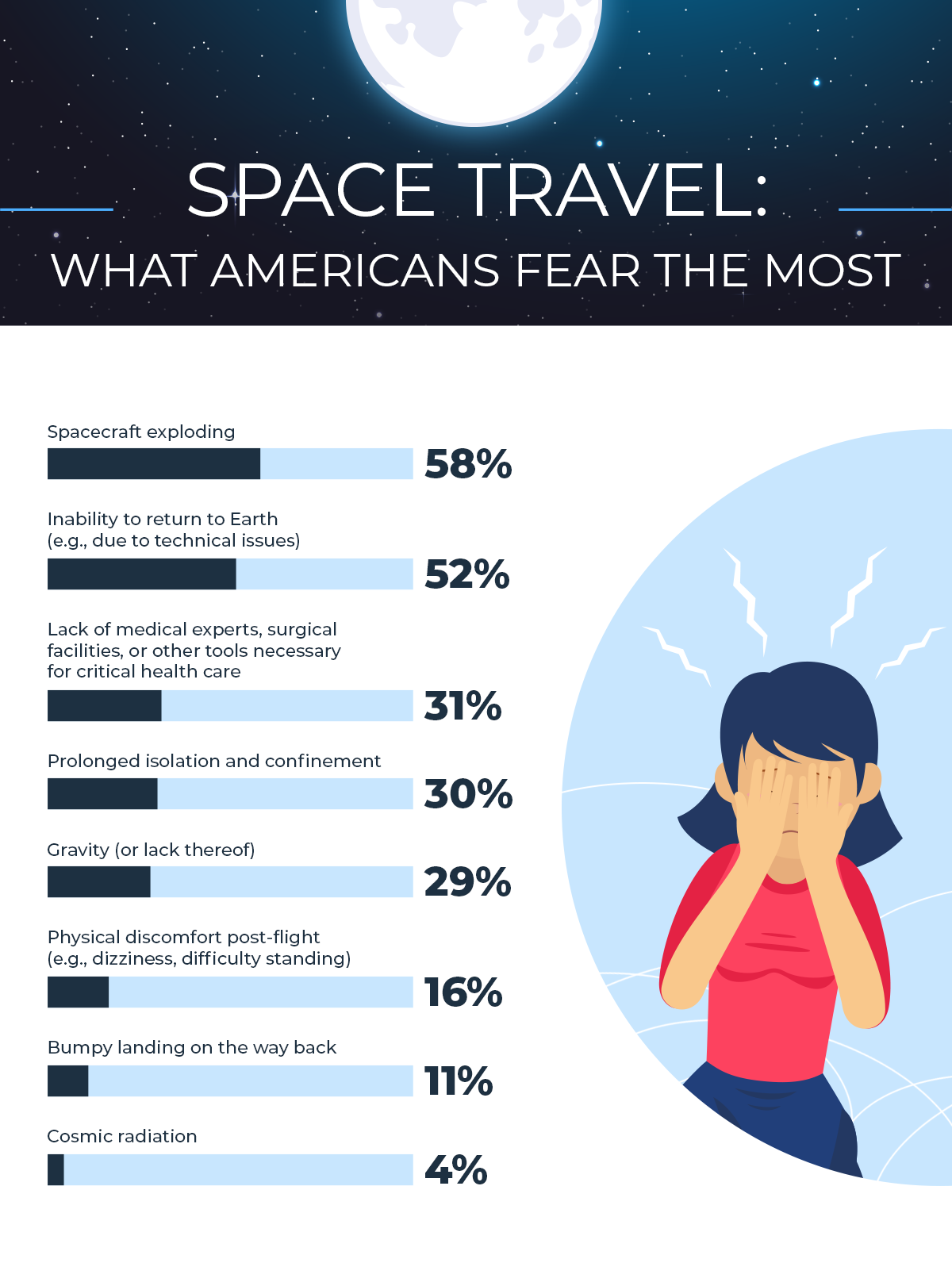
Lastly, we wanted to throw under the microscope Americans’ fears associated with space travel and see what they believe are the scariest parts of taking a trip to space.
Below are the results:
- Spacecraft exploding: 58%
- Inability to return to Earth (e.g., due to technical issues): 52%
- Lack of medical experts, surgical facilities, or other tools necessary for critical health care: 31%
- Prolonged isolation and confinement: 30%
- Gravity (or lack thereof): 29%
- Physical discomfort post-flight (e.g., dizziness, difficulty standing): 16%
- Bumpy landing on the way back: 11%
- Cosmic radiation: 4%
As evident from the above responses, “spacecraft exploding” and “inability to return to Earth” took the cake, by a wide margin. That’s not all that surprising given how many times we’ve seen spaceships explode in movies.
What we did find striking was that a full 29% of respondents are afraid of zero gravity.
Isn’t it a dream of many to experience weightlessness?
Perhaps, 29% of survey takers are privy to its adverse side-effects that include muscle atrophy, deterioration of the skeleton, and excess flatulence, among others.
Stacking It All Up
Space travel in 2022 is beyond reach for most people.
Yet, as more companies jump on the bandwagon, the ticket costs will eventually come down thanks to the competition and refinements that will follow.
Remember?
Air travel too was once exclusive and luxurious—back in the 1940s, the average flight from L.A. to Boston cost $4,539.24 per person in today’s money. Now, flying is accessible to most of us. So, let’s hope space tourism will follow suit.
Lastly, before we’re over and out, here’s a quick summary of the study’s key findings:
- Over half of Americans believe space tourism will become affordable for the general public within the next 25 years.
- Six out of 10 Americans (64%) want to travel to space. Yet, that number jumps to a whopping 82% for those who engage in adventurous activities (e.g., skydiving) and to 80% for Gen Zers.
- The remaining 36% of people in the USA who want to stay put most fear: spacecraft exploding (58%), inability to return to Earth (52%), and lack of medical experts, surgical facilities, or other tools necessary for critical health care (31%).
- The most common reasons to go to space are to “see Earth from space” (75%), followed by “look out into the universe” (55%), and “come to know what life in space is like” (41%).
- Nearly 60% of people in the US would want to go to the Moon and 28% would like to visit Mars.
- Yet, only 4% of Americans would splurge $100,000+ for a ride to space.
Methodology
We conducted an online survey of 1,079 US respondents via a bespoke online polling tool in November 2021. Its findings can be extrapolated to the general US population considering the survey’s age and gender makeup.
This study was created through multiple steps of research, crowdsourcing, and surveying. All survey participants’ responses were reviewed by data scientists for quality control. The survey had an attention-check question.
Fair Use Statement
Did our findings help you learn more about civilian space tourism? If you believe your audience will be interested in this information, feel free to share it. Just remember to mention the source and link back to this page.
Sources
- Chang K., “For Apollo 11 He Wasn’t on the Moon. But His Coffee Was Warm”
- Cole S., “Space Tourism: Prospects, Positioning, and Planning”
- Garcia M., “What Flights Used to Cost in the ‘Golden Age’ of Air Travel”
- Marais E., “Space Tourism: Rockets Emit 100 Times More Co₂ per Passenger than Flights – Imagine a Whole Industry”
- Manzey D., Kanas N., “Basic Issues of Human Adaptation to Space Flight”
- Sheetz M., “The Space Industry Will Be Worth Nearly $3 Trillion in 30 Years, Bank of America Predicts”
- Sheetz M., “Branson Is Trailing Bezos in Space Tourism, While Musk’s SpaceX Competes in a League of Its Own”
- Vakoch D., “Psychology of Space Exploration: Contemporary Research in Historical Perspective”

As a Digital PR specialist and a member of the Society of Professional Journalists (SPJ), Max has 5+ years of writing experience.
Over the course of his career, Max’s work has garnered significant attention, with features in numerous prominent publications such as The New York Times, Forbes, Inc., Business Insider, Fast Company, Entrepreneur, BBC, TechRepublic, Glassdoor, and G2.
